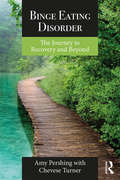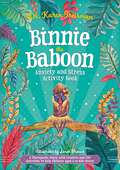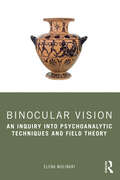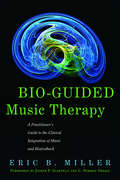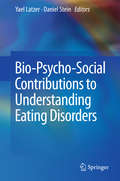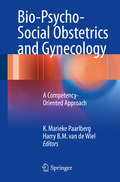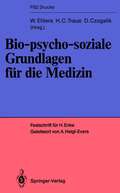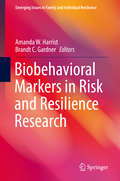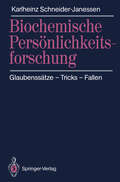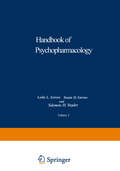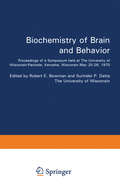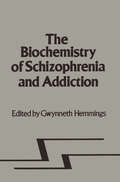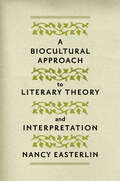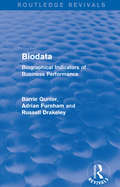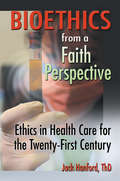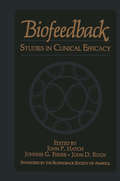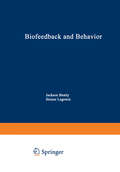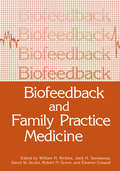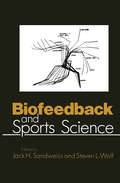- Table View
- List View
Binge Eating Disorder: The Journey to Recovery and Beyond
by Amy Pershing Chevese TurnerBinge Eating Disorder, written by a clinician and an advocate who have personally struggled with Binge Eating Disorder (BED), illuminates the experience of BED from the patient perspective while also exploring the disorder’s etiological roots and addressing the components of treatment that are necessary for long-term recovery. Accessible for both treatment providers and patients alike, this unique volume aims to explore BED treatment and recovery from both sides of the process while also providing a resource for structuring treatment and building effective interventions. This practical roadmap to understanding, resilience, and lasting change will be useful for anyone working clinically with or close to individuals suffering from BED, as well as those on the recovery journey.
Binge Eating Disorder: The Journey to Recovery and Beyond
by Amy Pershing Chevese TurnerBinge Eating Disorder, written by a clinician and an advocate who have personally struggled with Binge Eating Disorder (BED), illuminates the experience of BED from the patient perspective while also exploring the disorder’s etiological roots and addressing the components of treatment that are necessary for long-term recovery. Accessible for both treatment providers and patients alike, this unique volume aims to explore BED treatment and recovery from both sides of the process while also providing a resource for structuring treatment and building effective interventions. This practical roadmap to understanding, resilience, and lasting change will be useful for anyone working clinically with or close to individuals suffering from BED, as well as those on the recovery journey.
Binnie the Baboon Anxiety and Stress Activity Book: A Therapeutic Story with Creative and CBT Activities To Help Children Aged 5-10 Who Worry (Therapeutic Treasures Collection)
by Dr. Karen TreismanBinnie is an energetic baboon, who bounces around the lush green mountains of Rwanda in East Africa. But like many of us, Binnie often feels worried and stressed, and these worries can get in her way! What if she gets lost in the jungle, or her family gets sick? What if no one likes her? Sometimes she even worries about the fact she's worried; and if she isn't worried, well why not?! This activity book has been developed by expert child psychologist Dr Karen Treisman. The first part of the book is a colourful illustrated therapeutic story about Binnie the Baboon, with a focus on worry and anxiety. This is followed by a wealth of creative activities and photocopiable worksheets for children to explore issues relating to anxiety, worry, fears, and stress, and how to find ways to understand and overcome them. The final section of the book is full of advice and practical strategies for parents, carers, and professionals on how to help children aged 5-10 to start to understand why they experience feelings of anxiety, and what they can do to help reduce and navigate it.This activity book is complemented by a standalone picture book of Binnie's story, also available from Jessica Kingsley Publishers (Binnie the Baboon, ISBN 9781839970252).
Binocular Vision: An Inquiry into Psychoanalytic Techniques and Field Theory
by Elena MolinariBinocular Vision: An Inquiry into Psychoanalytic Techniques and Field Theory explains field theory from a Bionian perspective, while exploring the relationship between art and psychoanalysis.Elena Molinari starts from Bion’s double definition to explore the relationship between the conscious and unconscious thought process. She looks at a wide range of specific situations where field theory can be beneficial, from mother-baby therapy with a borderline mother, couple and group therapy, and the relationship of female subjectivity between an analyst and an adolescent analysand. In each situation, Molinari unpicks what Binocular Vision might mean as a transformative process used to explore the primitive parts of the mind. By doing so, she brings the reader back to the earliest developments of the primary relationship between analyst and client, and how this process can unite the psychoanalytic process and the artistic process.The book has been written for psychotherapists approaching and utilising field theory in child and adult psychoanalysis, and offers vital knowledge to clinicians working with patients in primitive states.
Binocular Vision: An Inquiry into Psychoanalytic Techniques and Field Theory
by Elena MolinariBinocular Vision: An Inquiry into Psychoanalytic Techniques and Field Theory explains field theory from a Bionian perspective, while exploring the relationship between art and psychoanalysis.Elena Molinari starts from Bion’s double definition to explore the relationship between the conscious and unconscious thought process. She looks at a wide range of specific situations where field theory can be beneficial, from mother-baby therapy with a borderline mother, couple and group therapy, and the relationship of female subjectivity between an analyst and an adolescent analysand. In each situation, Molinari unpicks what Binocular Vision might mean as a transformative process used to explore the primitive parts of the mind. By doing so, she brings the reader back to the earliest developments of the primary relationship between analyst and client, and how this process can unite the psychoanalytic process and the artistic process.The book has been written for psychotherapists approaching and utilising field theory in child and adult psychoanalysis, and offers vital knowledge to clinicians working with patients in primitive states.
Bio-Guided Music Therapy: A Practitioner's Guide to the Clinical Integration of Music and Biofeedback
by C. Norman Shealy Eric B. Miller Joseph P. ScartelliBio-Guided Music Therapy explores the clinical integration of music and biofeedback, providing the practitioner with a rationale, historical context and detailed step-by-step instructions for implementing real-time physiological data driven music therapy. This practical guide introduces the fundamental principles of biofeedback and explores the use of music therapy interventions in the context of achieving skills in self-regulation of physiological response. The book looks at the primary modalities of biofeedback, in conjunction with the assignment of digitally sampled musical voices to specific body functions. Additional music therapy interventions discussed include guided imagery to music, toning, mantra meditation, drumming and improvisation. We see how physiological data taken in the moment and combined with music therapy techniques, may be successfully applied to the treatment of stress, anxiety, high blood pressure, chronic pain, dementia, migraine, ADHD and addictions. Instructive and accessible, this book will prove an essential resource for students and practitioners of music therapy, biofeedback practitioners, social workers, psychologists and healing arts professionals.
Bio-Guided Music Therapy: A Practitioner's Guide to the Clinical Integration of Music and Biofeedback (PDF)
by C. Norman Shealy Eric B. Miller Joseph P. ScartelliBio-Guided Music Therapy explores the clinical integration of music and biofeedback, providing the practitioner with a rationale, historical context and detailed step-by-step instructions for implementing real-time physiological data driven music therapy. This practical guide introduces the fundamental principles of biofeedback and explores the use of music therapy interventions in the context of achieving skills in self-regulation of physiological response. The book looks at the primary modalities of biofeedback, in conjunction with the assignment of digitally sampled musical voices to specific body functions. Additional music therapy interventions discussed include guided imagery to music, toning, mantra meditation, drumming and improvisation. We see how physiological data taken in the moment and combined with music therapy techniques, may be successfully applied to the treatment of stress, anxiety, high blood pressure, chronic pain, dementia, migraine, ADHD and addictions. Instructive and accessible, this book will prove an essential resource for students and practitioners of music therapy, biofeedback practitioners, social workers, psychologists and healing arts professionals.
Bio-Psycho-Social Contributions to Understanding Eating Disorders
by Yael Latzer Daniel SteinThis book uniquely combines cutting-edge medical, psychological, and sociocultural topics pertinent to eating disorders. In the medical realm, the book focuses on Eating Disorders’ newly investigated associations with ADHD and sleep disorders, and on innovative treatments of osteoporosis in anorexia nervosa. Novel contributions in the psychological realm address families’ trans-generational transmission of Eating Disorders-related difficulties and novel internet-based treatments for such families. Lastly, in the sociocultural realm, the book discusses social contagion and Pro-Ana websites as increasing risk for disordered eating in young women around the globe. This volume provides readers with more holistic perspectives of each realm and their interplay, to promote Eating Disorders’ understanding, treatment, prevention, and research. It provides various professionals including mental health providers, physicians, nutritionists, and graduate students in these professions.
Bio-Psycho-Social Obstetrics and Gynecology: A Competency-Oriented Approach
by K Marieke Paarlberg Harry B.M. van de WielThis book will assist the reader by providing individually tailored, high-quality bio-psycho-social care to patients with a wide range of problems within the fields of obstetrics, gynaecology, fertility, oncology, and sexology. Each chapter addresses a particular theme, issue, or situation in a problem-oriented and case-based manner that emphasizes the differences between routine and bio-psycho-social care. Relevant facts and figures are presented, advice is provided regarding the medical, psychological, and caring process, and contextual aspects are discussed. The book offers practical tips and actions within the bio-psycho-social approach, and highlights important do’s and don’ts. To avoid a strict somatic thinking pattern, the importance of communication, multidisciplinary collaboration, and creation of a working alliance with the patient is emphasized. The book follows a consistent format, designed to meet the needs of challenged clinicians.
Bio-psycho-soziale Grundlagen für die Medizin: Festschrift für Helmut Enke (PSZ-Drucke)
by A. Catina D. Czogalik W. Ehlers R. Göllner R. Hettinger B. Hochkirchen M. Kessler D. Munz P. Novak H. Pohlmeier J. Siegrist G. W. Speierer D. V. Schmädel R. Teufel H. C. Traue J. V. Troschke V. Tschuschke W. Volk H. ZenzDie Erforschung der bio-psycho-sozialen Grundlagen der Medizin wird zunehmend notwendiger, weil die reine Beschränkung auf körperliche Aspekte von Krankheit nicht mehr dem Panoramawandel in der Medizin entspricht. Mit dem Einzug der Technologie in die medizinische Diagnostik wird für den modernen Arzt die Beziehung zum Patienten wieder wichtiger. Für die Forschung ergibt sich ein neues Spektrum von ungelösten Grundlagenproblemen. Das Buch führt in einige Grundlagenprobleme der Medizinischen Psychologie, Medizinischen Soziologie und Psychotherapie/Psychosomatik ein.
Biobehavioral Markers in Risk and Resilience Research (Emerging Issues in Family and Individual Resilience)
by Amanda W. Harrist Brandt C. GardnerThis comprehensive reference explores the current and future state of biobehavioral markers in family resilience research, with special focus on linking biological and physiological measures to behavioral and health outcomes. It brings together the latest biobehavioral data on child-parent and couple relationships, adversity, and other key areas reflecting new technological advances in biobehavioral studies and translates these findings into implications for real-world practice and policy. The contributors’ insights on biomarkers apply to emerging topics of interest (e.g., molecular genetics) as well as familiar ones (e.g., stress). Their interdisciplinary perspective helps to elaborate on risk and resilience factors for those creating the next generation of evidence-based interventions.Among the topics covered:The immune system as a sensor and regulator of stress: implications in human development and diseaseThe psychobiology of family dynamics: bidirectional relationships with adrenocortical attunementIntergenerational transmission of poverty: how low socioeconomic status impacts the neurobiology of two generationsThe influence of teacher-child relationships on preschool children’s cortisol levelsChallenges and strategies for integrating molecular genetics into behavioral scienceBesides its worth to researchers and practitioners studying and working with families at risk, Biobehavioral Markers in Risk and Resilience Research also has utility as a training text, offering a highly accessible presentation and discussion questions suited to classroom use.
Biochemische Persönlichkeitsforschung: Glaubenssätze — Tricks — Fallen
by Karlheinz Schneider-JanessenIst Wissenschaft irrational? Karlheinz Schneider-Janessen hat diese Frage für die biologisch orientierte Psychiatrie mit einem klaren Ja beantwortet. In den anderen Wissenschaften ist es zwar ebenso. Doch verschärft sich dieses Problem in der Medizin. Denn aus unreifen wissenschaftlichen Vorstellungen sind im letzten Jahrhundert oft allzu rasch falsche therapeutische Konsequenzen gezogen worden. Und dies geschieht - so ist zu befürchten - auch heute noch. Ein sehr kritisches, manchmal auch böses, aber doch notwendiges Buch. Ein Schmunzelbuch für jeden Wissenschafts-Skeptiker. Ein Lesebuch für Wissenschaftler allemal.
Biochemistry of Brain and Behavior: Proceedings of a Symposium held at The University of Wisconsin-Parkside, Kenosha, Wisconsin May 25–26, 1970
by Robert E. Bowmanment of mental retardation as in the young human. These two facts together suggest that the disrup tion of brain protein synthesis by high phenylala mine levels in infants may account for the mental retardation observed later in these children. Much work remains to be done to confi~m this possibility. However, it is clear from the review and research described by Waisman that neurochemis try has the tools that will lead to an understand ing of - and therefore perhaps control of - these inborn errors of metabolism which otherwise can lead to lifetimes of personal tragedy for the af fected persons and their families. The final section of these Proceedings deals with neurochemical processes which occur during brief behavioral experiences, particularly learn ing. The reported research has been motivated by the search for processes which underlie the encoding of memory, although the identification of these processes is not yet certain in the various studies. Geller and Jarvik begin with a discussion of short term and long term memory storage processes, and describe the induction of retrograde amnesia by various agents as evidence for these processes.
Biochemistry of Schizophrenia and Addiction: In Search of a Common Factor
by Gwynneth HemmingsThe main theme of this book concems the relationship, if any, between and addietion. Are they linked biochemieally? Is there a schizophrenia common factor for all addietions? We need to know whether the chemis try of addiction can help clarify the biochemistry of schizophrenia and vice versa. There is much anecdotal evidence that many sufferers from schizophrenia are addieted to smoking, are adversely affected by even small amounts of alcohol and do have their schizophrenie illness wor sened by street drugs. We would urge our readers to try to find correla tions between some of the findings described here on the biology of schizophrenia and what they read in the up-to-date chapters on addie tions. We would like to thank all the authors for the excellence of their work and for their cooperation and understanding of our needs and also, for the second time this year, to thank MTP Press for their willingness to pub lish a perhaps somewhat provocative book. We thank them for their humanity.
A Biocultural Approach to Literary Theory and Interpretation
by Nancy EasterlinCombining cognitive and evolutionary research with traditional humanist methods, Nancy Easterlin demonstrates how a biocultural perspective in theory and criticism opens up new possibilities for literary interpretation.Easterlin maintains that the practice of literary interpretation is still of central intellectual and social value. Taking an open yet judicious approach, she argues, however, that literary interpretation stands to gain dramatically from a fair-minded and creative application of cognitive and evolutionary research. This work does just that, expounding a biocultural method that charts a middle course between overly reductive approaches to literature and traditionalists who see the sciences as a threat to the humanities.Easterlin develops her biocultural method by comparing it to four major subfields within literary studies: new historicism, ecocriticism, cognitive approaches, and evolutionary approaches. After a thorough review of each subfield, she reconsiders them in light of relevant research in cognitive and evolutionary psychology and provides a textual analysis of literary works from the romantic era to the present, including William Wordsworth’s "Simon Lee" and the Lucy poems, Mary Robinson’s "Old Barnard," Samuel Taylor Coleridge’s "Dejection: An Ode," D. H. Lawrence’s The Fox, Jean Rhys’s Wide Sargasso Sea, and Raymond Carver’s "I Could See the Smallest Things."A Biocultural Approach to Literary Theory and Interpretation offers a fresh and reasoned approach to literary studies that at once preserves the central importance that interpretation plays in the humanities and embraces the exciting developments of the cognitive sciences.
A Biocultural Approach to Literary Theory and Interpretation (PDF)
by Nancy EasterlinCombining cognitive and evolutionary research with traditional humanist methods, Nancy Easterlin demonstrates how a biocultural perspective in theory and criticism opens up new possibilities for literary interpretation.Easterlin maintains that the practice of literary interpretation is still of central intellectual and social value. Taking an open yet judicious approach, she argues, however, that literary interpretation stands to gain dramatically from a fair-minded and creative application of cognitive and evolutionary research. This work does just that, expounding a biocultural method that charts a middle course between overly reductive approaches to literature and traditionalists who see the sciences as a threat to the humanities.Easterlin develops her biocultural method by comparing it to four major subfields within literary studies: new historicism, ecocriticism, cognitive approaches, and evolutionary approaches. After a thorough review of each subfield, she reconsiders them in light of relevant research in cognitive and evolutionary psychology and provides a textual analysis of literary works from the romantic era to the present, including William Wordsworth’s "Simon Lee" and the Lucy poems, Mary Robinson’s "Old Barnard," Samuel Taylor Coleridge’s "Dejection: An Ode," D. H. Lawrence’s The Fox, Jean Rhys’s Wide Sargasso Sea, and Raymond Carver’s "I Could See the Smallest Things."A Biocultural Approach to Literary Theory and Interpretation offers a fresh and reasoned approach to literary studies that at once preserves the central importance that interpretation plays in the humanities and embraces the exciting developments of the cognitive sciences.
Biodata (Routledge Revivals): Biographical Indicators of Business Performance
by Barrie Gunter Adrian Furnham Russell DrakeleyFirst published in 1993. This book is intended for managers and occupational psychologists involved in the selection and assessment of the workforce. It details the history and development of the use of biographical data for both recruitment and promotion of employees. Grounded in relevant research literature, it offers a comprehensive analysis of the advantages and disadvantages of biodata in different contexts. It also includes examples of applications and recommendations for use, as well as examples of questionnaires. Written by experts, it represents a wide-ranging review of the contemporary research in the field. This work will be of interest to students of business and psychology.
Biodata (Routledge Revivals): Biographical Indicators of Business Performance
by Barrie Gunter Adrian Furnham Russell DrakeleyFirst published in 1993. This book is intended for managers and occupational psychologists involved in the selection and assessment of the workforce. It details the history and development of the use of biographical data for both recruitment and promotion of employees. Grounded in relevant research literature, it offers a comprehensive analysis of the advantages and disadvantages of biodata in different contexts. It also includes examples of applications and recommendations for use, as well as examples of questionnaires. Written by experts, it represents a wide-ranging review of the contemporary research in the field. This work will be of interest to students of business and psychology.
Bioethics from a Faith Perspective: Ethics in Health Care for the Twenty-First Century
by Jack T Hanford Harold G KoenigDiscover the spiritual community's position on bioethics issues!Bioethics from a Faith Perspective: Ethics in Health Care for the Twenty-First Century offers a meaningful, rational, faith-oriented framework for deciding how to deal with important biomedical health care issues. Organ donation, managed care, the Human Genome Project, and medical technology that keeps people alive beyond their “natural” life span are some of the topics it illuminates through case analysis and resolution. Since almost all textbooks in bioethics omit the religious dimension of life (even though the field was inspired and stimulated by religious scholars at Princeton and Yale), this is an indispensable volume.While most people state their moral positions from the background of their religious traditions, many have not had the opportunity to study the relation between their faith perspectives and the difficult issues that arise in the pursuit of health care. This book shows the relevance, significance, and guidance that a faith perspective can offer for dealing with bioethical issues.This unique and thoughtful book: shows you how to distinguish and describe the relation between technical and ethical aspects of health-related issues provides you with a framework of moral principles, theories, values, and faith viewpoints teaches you the defining characteristics of a moral professional-client relationship related to faith helps you to discern when medical ethics and faith commitments are therapeutic and when they are not gives examples describing a moral problem, a faith perspective, and a justified position on that problemSince bioethics has been an amazing story of growth from the 1950s to the present day and is still expanding, there will be changes. Bioethics from a Faith Perspective stimulates that expansion by including the religious dimension. It is the perfect supplement to the existing literature on the subject.
Bioethics from a Faith Perspective: Ethics in Health Care for the Twenty-First Century
by Jack T Hanford Harold G KoenigDiscover the spiritual community's position on bioethics issues!Bioethics from a Faith Perspective: Ethics in Health Care for the Twenty-First Century offers a meaningful, rational, faith-oriented framework for deciding how to deal with important biomedical health care issues. Organ donation, managed care, the Human Genome Project, and medical technology that keeps people alive beyond their “natural” life span are some of the topics it illuminates through case analysis and resolution. Since almost all textbooks in bioethics omit the religious dimension of life (even though the field was inspired and stimulated by religious scholars at Princeton and Yale), this is an indispensable volume.While most people state their moral positions from the background of their religious traditions, many have not had the opportunity to study the relation between their faith perspectives and the difficult issues that arise in the pursuit of health care. This book shows the relevance, significance, and guidance that a faith perspective can offer for dealing with bioethical issues.This unique and thoughtful book: shows you how to distinguish and describe the relation between technical and ethical aspects of health-related issues provides you with a framework of moral principles, theories, values, and faith viewpoints teaches you the defining characteristics of a moral professional-client relationship related to faith helps you to discern when medical ethics and faith commitments are therapeutic and when they are not gives examples describing a moral problem, a faith perspective, and a justified position on that problemSince bioethics has been an amazing story of growth from the 1950s to the present day and is still expanding, there will be changes. Bioethics from a Faith Perspective stimulates that expansion by including the religious dimension. It is the perfect supplement to the existing literature on the subject.
Biofeedback: Studies in Clinical Efficacy
by John P. Hatch, Johnnie G. Fisher and John D. RughThe chapters of this book were prepared as task force reports under the aegis of the Biofeedback Society of America (BSA). The impetus for the present generation of task force reports can be dated back to 1982, when John D. Rugh, as President-Elect of the Society, announced that the updating of the task force reports would be given high priority during his term as President. An ad hoc Task Force Committee was appointed in 1983, and the committee set the following objectives: (1) solicit a widely based stream of input from all segments of the Biofeedback Society of America, (2) establish a peer review system to assure the highest degree of scholarship and an unbiased approach, (3) select for area authors only individuals who have profound knowledge of the area and who have demonstrated the ability to extend understanding by reviewing and criticizing the literature, (4) prepare all reports according to a standard ized format, and (5) publish all the reports simultaneously. Input came from several sources. Many people responded with ideas and suggestions to an announcement in the BSA Newsletter that the task force reports were being revised. In 1984, a symposium was conducted at the BSA annual meeting, which included round table dis cussions and dialogues between task force report authors and the BSA membership.
Biofeedback and Behavior (Nato Conference Series #2)
by Jackson BeattyBiofeedback and Behavior: A NATO Symposium, held on 27-30 July 1976 at the Max Planck Institut fUr Psychiatrie in MUnchen, was a mul tidisciplinary meeting that explored both theoretical and applied issues arising from the use of biofeedback procedures for the control of visceral, central nervous system and skeletal events. The symposium was multi national in its composition. Financial support for the symposium was initially provided by the Scientific Affairs Division of the North Atlantic Treaty Organization as part of their continuing series of scientific symposia. Funds made avail able by a grant from the United States Office of Naval Research permit ted wide-spread international participation in the symposium. The facil ities for the meeting were graciously provided by the Max Planck Institut ilir Psychiatrie. We thank each of these organizations for their support in making this symposium possible. A special thanks is due to Dr. B.A. Bayraktar of the Scientific Affairs Division of NA TO and Dr. Donald Wood ward of the U.S. Office of Naval Research, whose counsel contributed substantially to the organization of this meeting. The planning of this symposium was carried out in consultation with members of the organizing committee: Rolf Engel, Pola Engel-Sittenfeld, Laverne C. Johnson, George H. Lawrence, Gary E. Schwartz, and Da vid Shapiro. The final form of this symposium reflects their contribu tions, for which we are grateful.
Biofeedback and Family Practice Medicine
by EleanorCriswell Robert N. Grove David W. Jacobs Jack H. Sandweiss William H. RicklesDuring the past five years there has been a reawakening of interest in the psychotherapy of patients with medical disorders characterized as psychosomatic. For three decades, psychoanalysis and psychoanalytic psychotherapy were used extensively to treat and study psychosomatic disorders. Early in the 1960s, interest in this approach to these conditions faded, and the ·Psychosomatic Service· in most hospitals became the ·Consultation Liaison Service· (Lipowski, 1967). The recent focus of biofeedback on psychosomatic conditions provides a new technique with which the physician or psychiatrist may treat these patients (Rickles, 1981). In addition, the successful application of biofeedback training to a variety of complaints such as those presented in this volume has heralded the addition of biofeedback to the treatment modalities used for medical complaints. Frequently, psychological factors can still be seen; for example, when biofeedback treatment may require lifestyle changes on the part of the patient, the exploration of secondary gains or resistances before the disorder can be success fully treated, and the establishment of rapport and empathy which is so important for truly effective biofeedback training. Aside from certain psychological dimensions that are always present in biofeed back training, in this case biofeedback is being used in a primarily medical setting for primarily medical complaints.
Biofeedback and Sports Science
by Steven L. Wolf Jack H. SandweissThere is a new breed of athletic coach in the educational arena. While on speaking engagements around the world, I've en couraged coaches to jump "head first" and quickly into sports science. The reason is simple. With new electronic commu nication systems coming on the market almost daily, athletes can get valid and reliable information to help them maximize sports skills, and this information can come faster than most coaches are able to deliver. Coaches have historically rejected most sports science efforts in favor of traditional"seat of the pants" systems, but now there is a new kind of athlete who is asking questions never before presented to the coach. Professional athletes are individually seeking out sports scientists for answers to their particular problems. Stories appear daily in the media about athletes making quantum jumps in performance as a result of their association with sports scientists. The tidal wave is building and no one can stop it-not even the sporting goods industry. "High-tech" athletic equipment is now a must in nearly every sport. Large sporting goods companies have nearly gone bankrupt because of competitors' new "high-tech" prod ucts. ix X FoREWORD The tail is wagging the dog. Professional, amateur, and weekend athletes alike are demanding technical answers of our sports leaders, and they are going elsewhere if the correct answers aren't available. The number of Olympic athletes visiting our Coto Research Center in California is staggering.
